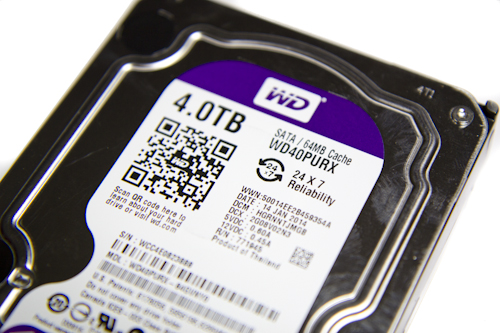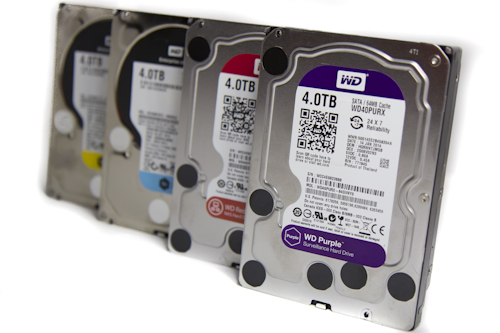Surveillance Hard Drive Shoot-Out: WD And Seagate Square Off
Video surveillance has been around for years. Grainy gas station cameras are giving way to higher-end 1080p-capable IP cameras, and storage is evolving to meet the needs of these ever-expanding solutions. Today we look at two new entries into the market.
Western Digital Purple
In Western Digital's never-ending quest to snag every color in the rainbow, we now have the WD Purple, which is surveillance-specific. Right under WD's purple banner, there is a large QR code that sends you straight to the drive's webpage.
The Purple is a follow-up to the video- and surveillance-oriented WD-AV GP, which supported WD's SilkStream technology. The purpose of SilkStream was to facilitate up to 12 simultaneous HD video streams utilizing the ATA Streaming Command Set. With the Purple, WD rebrands SilkStream to AllFrame, which now supports 32 HD cameras/channels.
It's interesting to note the way WD is positioning this product. Unlike traditional hard drives, where access times and throughput are prominently displayed, the Purple employs the target market's vernacular, which is number of channels/cameras. To go along with its marketing change-up, WD provides some really nice tools on its website to help guide customers to the correct WD product.
- Compatibility: Select from over 20 surveillance system vendors and countless models to see which WD hard drives are supported.
- Product Selector: Select the number of cameras, drive bays, interface, and environment, and WD recommends the best product line.
- Capacity Selector: Enter the details of the video feeds, and WD lets you know how much capacity your system will require.
Although the Purple is meant strictly for surveillance, WD still recommends the enterprise Se and Re lines for large enterprise surveillance systems. As you will see in our test results, those two families aren't slouches in this segment, either. In fact, they are better than the Purple in almost every way, except for cost. That's really the point of the Purple, though; achieve enterprise levels of performance for a very specific task at a vastly reduced price point. Even though the Purple is well-suited to this particular workload, there are compromises you make.
| Header Cell - Column 0 | Purple | Se | Re |
|---|---|---|---|
| Applications | Home/SOHO/SMB | SOHO/SMB/SME | SME/Large enterprise |
| Recommended # of Drives | 1-8 | 6+ | 6+ |
| Typical # of Cameras | 1-32 | 1-64 | Unlimited |
| # of Channels | Up to 32 | Up to 64 | 64 or more |
| Workload (TB/year) | 60 | 180 | 550 |
| Form Factor | 3.5" | 3.5" | 3.5" |
| Capacity | 1, 2, 3, 4 TB | 1, 2, 3, 4 TB | 250, 500 GB, 1, 2, 3, 4 TB |
| Mission-Critical | No | No | Yes |
| Power | 5.1 W | 9.5 W | 11 W |
| MTTF | 1 million-hr. | 1 million-hr. rack-mount1.2 million-hr. table-top | 1.2 million-hr. |
| Warranty | Three-year | Five-year | Five-year |
| Interface | SATA | SATA | SATA or SAS |
| Performance | IntelliPower | 7200 RPM | 7200 RPM |
| RAFF Support | No | Yes | Yes |
For those of you who don't spend your days poring over datasheets, the workload rating may come as a surprise. SSD customers are accustomed to seeing a write endurance specification because NAND deteriorates over time, and its useful life can at least be estimated. With rotating media, there is an assumption that enterprise-oriented drives intended for 24/7 operation can be written to all day, every day, for their entire lifespan.
Recently, WD changed the way it rates its drives and now includes that workload specification, indicating how many terabytes of data can be written to the drive per year. Unlike the SSD world, this isn't related to the media's ability to hold data. Rather, it's more closely tied to the MTTF rating. Exceeding WD's number effectively reduces the longevity of the drive, which is guaranteed for three years. But of course, as with SSDs, the higher-quality components required to sustain increasingly taxing workloads drive up cost. The Re family is rated for a workload nine times higher than the Purple, and consequently is more expensive.
The next differentiator is the recommended number of drives. Specific to the Purple, WD suggests no more than eight in a system, and they're not intended for rack-mount applications. This is mainly due to a lack of Rotary Acceleration Feed Forward (RAFF), a technology that overcomes the effects of vibration introduced by other drives in an enclosure. In server applications, where dozens or hundreds of drives can share the same rack, RAFF is necessary. Clearly, WD doesn't believe that functionality is required for the Purple's target market.
Get Tom's Hardware's best news and in-depth reviews, straight to your inbox.
For this review, we were not only able to test WD's Purple, but also its Red, Se, and Re, all with 4 TB of capacity.
Current page: Western Digital Purple
Prev Page Introducing Surveillance-Specific Hard Drives Next Page Seagate Surveillance HDD-
coolestcarl Excellent article. I was doing research into building a custom surveillance system for our shop and this is exactly the kind of material that would help me make an informed decision.Reply -
coolestcarl One thing that was unclear... obviously WD recommends no more than 8 in a system because of the lack of RAFF. I was wondering:Reply
Are there any demonstrable effects on performance of having these drives in a small external raid array (of perhaps 4 drives)? -
AndrewJacksonZA "As I noted earlier, those Seagate models are in there as a performance reference; they wouldn't normally compete in the same space as the Purple and Surveillance HDD."Reply
If you're going to wander into the USD1/GB+ territory, even just for informational purposes, please include an SSD in this mix to be fair. SSD performance/price just might validate people buying them for surveillance drives.
Thank you. -
InvalidError I would have whacked a WD Black in there to see how all these specialty drives compare against a standard performance-oriented desktop drive.Reply -
mapesdhs ReplyI would have whacked a WD Black in there to see how all these specialty drives compare against a standard performance-oriented desktop drive.
Indeed, or any typical Enterprise SATA model (Hitachi HUS, Seagate ES2/NS, etc.)
Come to think of it, given the consequences of not being able to identify a suspect or
obtain other relevant visual information due to dropped data, as AndrewJacksonZA
says it would be interesting to know how these drives compare to various high-capacity
SSHDs/SSDs, eg. the Seagate 4TB ST4000DX001, Samsung 840 EVO 1TB (which includes
AES), and (high-density option, power saving) the Samsung MZ-MTE1T0BW 1TB mSATA.
The higher cost/GB of these products is surely more than worth it given the intended task.
Ian.
-
CaedenV Great article! I had no idea at just how huge the performance gap was between the cheap consumer drives and their more industrial cousins in the enterprise market. Have to say though; with enterprise SSDs starting to come down in price with such better specs, it is going to be difficult to justify enterprise hard drives that still cost $1+/GB. I think we are going to see SSD adoption grow like crazy in those enterprise markets the next few years, especially with drives starting to have 5-10 year warranties.Reply
Article idea: No offence to the writers at Tom's but this is the first interesting article I have read in a long time. Could we get some more articles like this? Maybe some articles comparing onboard Intel RAID with different popular card options? Or comparing how different drives perform in different RAID configurations and workloads? I get the feeling that these drives would perform quite differently as they are really made to work as a team rather than as solo drives. -
InvalidError Reply
You would need one grossly under-engineered surveillance system for this to really be a problem since there is nothing happening 99% of the time and those drops would need to conveniently happen during the 1% of the time where you need data and your system administrator would need to have somehow failed to notice and fix the issues in-between events if they were so bad as to render the system unusable for its intended purpose.13537984 said:Come to think of it, given the consequences of not being able to identify a suspect or obtain other relevant visual information due to dropped data
Most of the time though, surveillance recordings are merely a nice convenience in case something goes wrong but are not considered critical outside of casinos, banks and few other (very) high security applications that have their own IT departments or dedicated vendors working on their video archival needs and are unlikely to take their hardware recommendations from enthusiast sites like THG.
I doubt any normal company would waste SSDs or 10k/12k/15k RPM HDDs on video surveillance storage. They would be more likely to use standard HDDs like WD Black / Red / Green / Blue. -
Amdlova seagate in enterprise sector is better than WD. i See these little boys working on a PC and DO such amazing job. Running windows and a old Surveillance card with 32 cameras and you can see the videos and edit at same time.Reply -
drewriley Reply13537984 said:Come to think of it, given the consequences of not being able to identify a suspect or
obtain other relevant visual information due to dropped data, as AndrewJacksonZA
says it would be interesting to know how these drives compare to various high-capacity
SSHDs/SSDs, eg. the Seagate 4TB ST4000DX001, Samsung 840 EVO 1TB (which includes
AES), and (high-density option, power saving) the Samsung MZ-MTE1T0BW 1TB mSATA.
The higher cost/GB of these products is surely more than worth it given the intended task.
Ian.
I really debated on whether to include SSDs in the evaluation. The problem is that because of $/GB and write endurance, it would only make sense to use them on a smaller scale setup, which is where their benefits (simultaneous high speed IO), are greatly reduced. Also, their performance would skew the graphs to the point where it would be hard to interpret the results of the HDDs.

